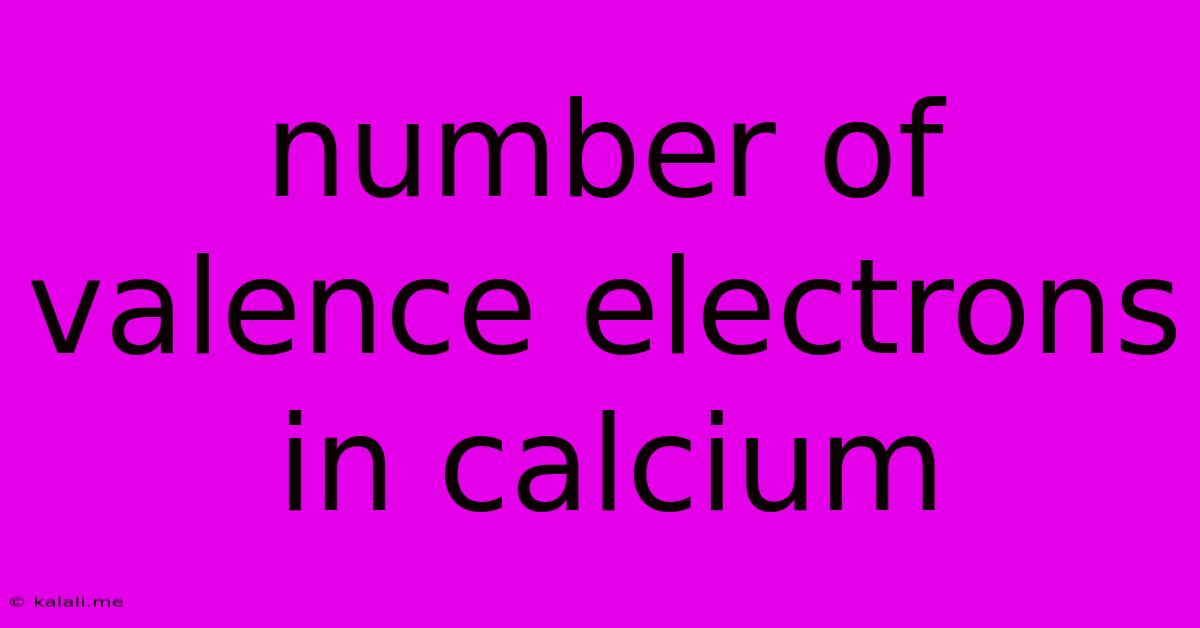Number Of Valence Electrons In Calcium
Kalali
May 09, 2025 · 2 min read

Table of Contents
Understanding the Number of Valence Electrons in Calcium
Calcium, a vital element for human health and numerous industrial applications, plays a significant role in various chemical reactions. Understanding its electronic structure, particularly the number of valence electrons, is crucial to comprehending its reactivity and bonding behavior. This article will delve into the details of determining the number of valence electrons in calcium, exploring its electron configuration and implications.
What are Valence Electrons?
Before we dive into the specifics of calcium, let's define valence electrons. Valence electrons are the electrons located in the outermost shell of an atom. These electrons are the ones involved in chemical bonding, determining an element's reactivity and the types of compounds it can form. Understanding valence electrons is key to predicting chemical behavior.
Determining Calcium's Valence Electrons
Calcium (Ca) has an atomic number of 20, meaning it possesses 20 protons and 20 electrons in a neutral atom. To determine the number of valence electrons, we need to examine its electron configuration. The electron configuration of calcium is 1s²2s²2p⁶3s²3p⁶4s².
This configuration shows how the electrons are distributed across different energy levels or shells. The outermost shell, in this case, is the fourth shell (n=4), which contains the 4s² electrons. Therefore, calcium has 2 valence electrons.
Why are these 2 Valence Electrons Significant?
The presence of two valence electrons explains Calcium's chemical behavior:
-
Reactivity: Elements strive to achieve a stable electron configuration, often resembling a noble gas. Calcium readily loses its two valence electrons to attain a stable octet (eight electrons in its outermost shell), similar to Argon. This explains its strong tendency to form ionic bonds with nonmetals, readily giving up its electrons to become a Ca²⁺ ion.
-
Bonding: Because of its two valence electrons, calcium predominantly forms ionic compounds. It readily reacts with elements like oxygen (forming calcium oxide, CaO) and chlorine (forming calcium chloride, CaCl₂), where it loses its two valence electrons to achieve a stable electron configuration.
-
Oxidation State: The tendency to lose two electrons makes +2 the most common oxidation state for calcium in its compounds. This is a direct consequence of its two valence electrons.
-
Metallic Properties: The relatively loose hold on its valence electrons contributes to calcium's metallic properties, such as good electrical and thermal conductivity.
In Summary:
Calcium's electronic structure reveals that it has two valence electrons. This crucial fact explains its chemical reactivity, typical bonding patterns (primarily ionic), common oxidation state (+2), and characteristic metallic properties. Understanding the number of valence electrons is a fundamental concept in chemistry, crucial for predicting and understanding the behavior of elements. This knowledge extends to its various applications, from biological processes to industrial uses, highlighting the importance of its electronic structure in its overall properties.
Latest Posts
Latest Posts
-
375 As A Fraction In Simplest Form
May 09, 2025
-
38 Centimeters Equals How Many Inches
May 09, 2025
-
What Is The Electron Configuration Of Bromine
May 09, 2025
-
How Much Is 2 Miles In Km
May 09, 2025
-
4 4 Centimeters Is How Many Inches
May 09, 2025
Related Post
Thank you for visiting our website which covers about Number Of Valence Electrons In Calcium . We hope the information provided has been useful to you. Feel free to contact us if you have any questions or need further assistance. See you next time and don't miss to bookmark.